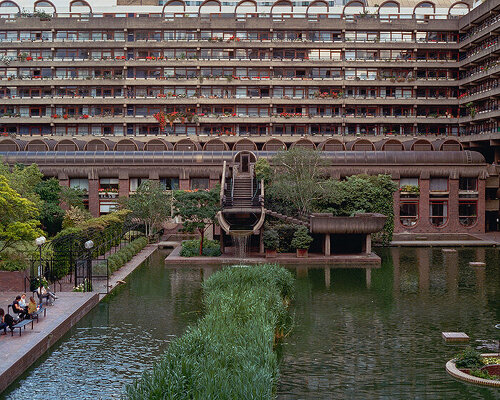david altrath reveals the atmospheres that animate the barbican
Photographer David Altrath walks the Barbican Centre, tracing how elevated walkways, heavy concrete masses, and layered water landscapes shape one of Britain’s boldest experiments in high-density urban living. Designed by Chamberlin, Powell, and Bon and completed in 1982, the estate rises from post-war London. Altrath focuses on the constant shifts of light, weather, and movement that animate the megastructure of the Brutalist icon.
The scale of the estate is felt in the sweeping view of its terrace blocks rising over the central green. Narrow balconies wrap the long facades, filled with red flowers, potted plants, and the everyday objects of residents. Below, a lawn dotted with picnics and a small playground softens the geometry, revealing the original intention of the architects to merge high-density housing with generous public space. Behind the horizontal stack of apartments, the crisp verticality of newer office towers reminds viewers of the role of the estate as a cultural enclave carved into the commercial center of the city.
all images by David Altrath
elevated paths and water gardens shape the brutalist landmark
Moving into the complex, Hamburg-based photographer Altrath focuses on its elevated pedestrian routes, the system of brick-tiled walkways that binds the estate together. One corridor curves under a low concrete canopy, framed by slender black steel posts and lit by a soft glow that pushes the eye outward toward surrounding trees. Another walkway runs straight into a thicket of cylindrical columns, their rough-cast surfaces catching the daylight. A painted yellow line down the center subtly hints at the estate’s circulation logic, a city built for walkers above the traffic of the ground plane.
At the water gardens, layered terraces, fountains, and planted islands unfold in a slow gradient toward the lake. Altrath catches families perched on a circular brick island feeding ducks, reeds rustling in the wind, and sunlight flickering through the surface of the ponds. The rhythm of the fountains runs parallel to the long reflections of the residential towers, tying the vertical and horizontal scales of the Barbican into one continuous landscape.
David Altrath walks the Barbican Centre
london’s urban past through concrete, water, and film
From beneath the terrace blocks, the camera turns to the estate’s undercrofts, vast yet quiet spaces where columns descend straight into the water and the echoes of the city fade. Altrath frames these supports as sculptural elements, highlighting the surprising delicacy in their arrangement despite the weight they carry overhead.
Throughout the series, fragments of older London appear between concrete planes through church windows, pale stone facades, and medieval remnants peeking through the estate’s elevated pathways. These juxtapositions underline the Barbican’s layered history, a reconstruction of a bombed district, a proclamation of modernist ideals, and now a cultural landmark continuously reshaped by its users.
Shot on Kodak Vision3 250D and 500T, the photographs embrace the warmth, grain, and atmospheric softness of film. Altrath uses the medium to pull out the shift of color across aggregate surfaces, the texture of water meeting brick, and the way planted edges soften the monumental presence of the estate.
elevated walkways, heavy concrete masses, and layered water landscapes shape the complex
one of Britain’s boldest experiments in high-density urban living
designed by Chamberlin, Powell, and Bon and completed in 1982
Altrath focuses on the constant shifts of light, weather, and movement that animate the megastructure
the scale of the estate is felt in the sweeping view of its terrace blocks rising over the central green
narrow balconies wrap the long facades
the camera turns to the estate’s undercrofts
brick-tiled walkways bind the estate together
moving into the complex, Altrath focuses on its elevated pedestrian routes
rough-cast surfaces
the photographs embrace the warmth, grain and atmospheric softness of film
Altrath uses the medium to pull out subtleties often overlooked in Brutalist structures
the cultural landmark is continuously reshaped by its users
a cultural enclave carved into the commercial center of the city
project info:
name: Barbican Centre
photographer: David Altrath | @davidaltrath
architects: Chamberlin, Powell and Bon
location: London, Great Britain
The post concrete towers, water gardens and elevated paths: the barbican through david altrath’s lens appeared first on designboom | architecture & design magazine.

